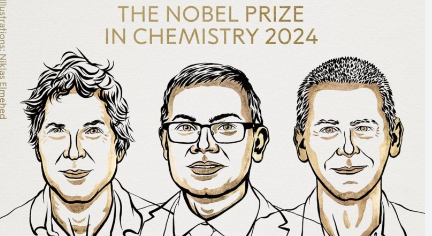Baker, Hassabis, Jumper Awarded Nobel 2024 in Chemistry for Pioneering Protein Research (GS Paper 3, Science & Technology)

Why in News?
- The 2024 Nobel Prize in Chemistry has been awarded to David Baker, Demis Hassabis, and John M. Jumper for their groundbreaking contributions to the field of protein research.
- Baker is recognized for his pioneering work in computational protein design, while Hassabis and Jumper are celebrated for their development of AI-based protein structure prediction methods.
- This honor, bestowed by the Royal Swedish Academy of Sciences, underscores the transformative impact of their research on biology, medicine, and environmental science.
Award Details
- Awarding Body: Royal Swedish Academy of Sciences
- Prize Distribution:
- David Baker: Awarded half of the prize for innovative contributions to computational protein design.
- Demis Hassabis and John M. Jumper: Jointly awarded the other half for their collaborative work in protein structure prediction.
The Fundamental Role of Proteins
Proteins are essential macromolecules that perform a vast array of functions within living organisms. Composed of 20 different amino acids, proteins play critical roles in biological processes, including:
- Catalyzing biochemical reactions: Enzymes are proteins that speed up chemical reactions.
- Structural support: Proteins provide structural integrity to cells and tissues (e.g., collagen in connective tissues).
- Cell signaling: Proteins function as hormones and signaling molecules that mediate communication between cells.
- Immune response: Antibodies, which are proteins, help the body defend against pathogens.
The specific function of a protein is determined by its three-dimensional structure, which arises from the complex folding of its amino acid chain.
David Baker: Innovator in Computational Protein Design
Milestone Achievement (2003)
David Baker’s transformative work began in 2003 when he successfully designed a protein with no natural equivalent. This achievement laid the groundwork for his ongoing research at the University of Washington, where his team has created numerous novel proteins with diverse applications, including:
- Pharmaceuticals and Vaccines: Designing proteins that can be used in drug development and vaccine formulation.
- Nanomaterials: Creating proteins that can assemble into nanostructures for use in materials science.
- Sensors: Developing tiny proteins that can act as sensors for detecting specific molecules or conditions.
Baker’s research involves reengineering proteins, enabling scientists to create tailored proteins that can perform specific functions or interact with other biomolecules effectively.
Demis Hassabis and John Jumper: AI in Protein Structure Prediction
Historical Challenge
- For decades, the scientific community faced the challenge of predicting protein structures from amino acid sequences.
- Understanding how proteins fold is essential for elucidating their functions, but the intricate nature of folding processes made this a complex problem.
Breakthrough with AlphaFold2 (2020)
In 2020, Hassabis and Jumper unveiled AlphaFold2, an advanced AI model that revolutionized the field of structural biology. AlphaFold2 achieved unprecedented accuracy in predicting the 3D structures of proteins, successfully determining the structures of nearly all known proteins—over 200 million in total. This breakthrough has been pivotal, resulting in:
- Widespread Adoption: AlphaFold2 has been utilized by more than 2 million users across 190 countries, making it a cornerstone of contemporary biological research.
- Diverse Applications: The model has been applied in various fields, including:
- Antibiotic Resistance Research: Understanding the mechanisms that allow bacteria to resist antibiotics.
- Enzyme Visualization: Helping researchers visualize enzymes capable of breaking down environmental pollutants like plastics.
Why These Discoveries Matter
The combined efforts of Baker, Hassabis, and Jumper open up vast possibilities for scientific advancement. Key implications of their work include:
- Drug and Vaccine Development: The ability to design new proteins allows for the rapid development of novel therapeutic agents, improving response times to emerging health crises.
- Addressing Global Challenges: By designing proteins that can combat antibiotic resistance and create biodegradable materials, researchers can tackle pressing environmental and health issues.
- Enhancing Biological Understanding: Their work contributes significantly to our understanding of biology at a molecular level, potentially leading to new discoveries in various biological fields.
Biographical Highlights of the Laureates
- David Baker
- Born: 1962 in Seattle, WA, USA
- Education: PhD from the University of California, Berkeley (1989)
- Affiliation: Professor at the University of Washington, Seattle, WA, USA
- Notable Contributions: Pioneered computational methods to design new proteins and explore their functions.
- Demis Hassabis
- Born: 1976 in London, UK
- Education: PhD from University College London (2009)
- Affiliation: CEO of Google DeepMind, London, UK
- Notable Contributions: Developed advanced AI algorithms for protein structure prediction, leading to significant breakthroughs in biological research.
- John M. Jumper
- Born: 1985 in Little Rock, AR, USA
- Education: PhD from the University of Chicago (2017)
- Affiliation: Senior Research Scientist at Google DeepMind, London, UK
- Notable Contributions: Played a crucial role in the development of AlphaFold2, enhancing predictive accuracy in structural biology.
Prize Amount
- The total prize amount awarded is 11 million Swedish kronor, with David Baker receiving half of the prize, while Demis Hassabis and John Jumper share the other half.
Conclusion
- The 2024 Nobel Prize in Chemistry acknowledges the groundbreaking advancements in protein research brought about by Baker, Hassabis, and Jumper.
- Their work not only furthers our understanding of fundamental biological processes but also offers innovative solutions to some of the most pressing challenges facing humanity today.
- The intersection of computational design and artificial intelligence in their research promises to shape the future of medicine, environmental science, and biotechnology.


